It looks like you're using an Ad Blocker.
Please white-list or disable AboveTopSecret.com in your ad-blocking tool.
Thank you.
Some features of ATS will be disabled while you continue to use an ad-blocker.
share:
reply to post by tsurfer2000h
That one looks more vertical than horizontal . But then again I can't be sure. Can you tell me what a vertical trail would look like ? ( without launching the space shuttle from the Albertson's parking lot.
That one looks more vertical than horizontal . But then again I can't be sure. Can you tell me what a vertical trail would look like ? ( without launching the space shuttle from the Albertson's parking lot.
So if I'm laying on my right side on the ground is this a left handed contrail or right?? The whole chemtrail religeon confuses me
reply to post by CherubBaby
Here is an article you might enjoy.... Visible vortices/ Flight Magazine September 5,1940
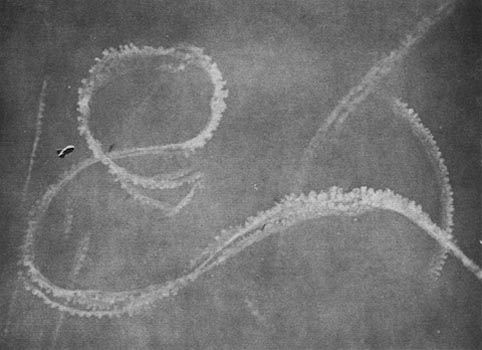
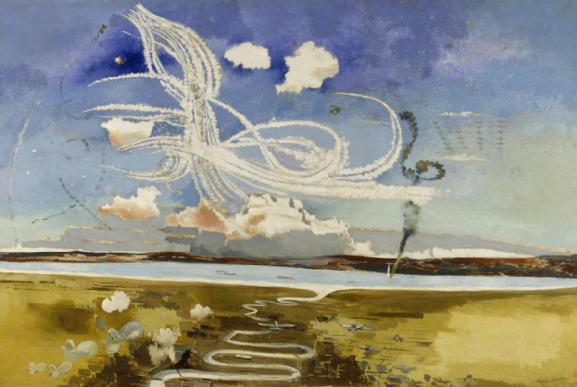
Visible vortices
Here is an article you might enjoy.... Visible vortices/ Flight Magazine September 5,1940
Some readers may have observed lately what they at first thought to be sky-writing, and a member of the staff of Flight saw a particularly good example on Sunday afternoon, July 7, over London.
The same sort of thing had been seen previously, but this was the best example to date and exhibited some features not observed on other occasions. For the benefit of those who have not seen the phenomenon it consists of a thin line of what looks like white cloud, or perhaps of very white smoke made by a sky-writing aeroplane.
The explanation which has been given before as a possible reason for visibility of these vortices is that there is condensation of moisture. Such condensation might perhaps be caused in regions of low pressure which may be those parts of the vortex where the velocity is highest.
Perhaps there is significance in the fact that it is at the tip of the airscrew (where the blade velocity is greatest) that the visible ring occurs. A fog formed by reduction of pressure can be seen in tunnelling work under the earth when, in order to keep out water, compressed air is supplied to the working face. The men, to get out, have to go into a chamber where the pressure is reduced before they can go into atmospheric pressure. During this decompression, the whole chamber may be filled with fog.
In the case of the trail behind an aeroplane, the condensation theory might be correct as there is plenty of water vapour in the products of combustion in the exhaust gas. If the atmospheric conditions are right, the condensation would certainly cause a visible trail.


But even though (as we now know) this explanation was essentially correct, there was as yet no proof, and there followed considerable correspondence from readers. (Some helpfully suggested that that the visible vortices might be used to track enemy aircraft, either by fighters underneath during the day, or by searchlights at night.)
By September Flight felt it had enough information to tentatively confirm its earlier hypothesis, and also to note that there were two types of visible vortices: long-lived helical ones from engine exhaust ('slipstream trails'), and short-lived ones from wingtips ('wing tip trails').
In 1942 de Havilland published a similar but more technical explanation of both types of contrail, so it seems that Flight's theory had become widely accepted.
A mathematical theory of contrail formation was independently formulated in Germany in 1941 and in the United States in 1953.
Visible vortices
Originally posted by NONPOINT21
reply to post by network dude
You are in the dark my friend.
Perhaps, but I sleep better knowing that the clouds are just clouds and not evil bad juice sprayed by the bad man to kill us all. clouds=good.
Oh, and the tooth fairy isn't real either. Sorry about that one. (it crushed me as well.)
reply to post by Drunkenparrot
That's a nice article but the point is, the pictures don't depict dog fighting, rocket launches or skywriting.
That's a nice article but the point is, the pictures don't depict dog fighting, rocket launches or skywriting.
Originally posted by CherubBaby
reply to post by Drunkenparrot
That's a nice article but the point is, the pictures don't depict dog fighting, rocket launches or skywriting.
It doesn't matter what an a/c or rocket is DOING when it creates a contrail - it only matters that it is burning a fuel that creates water, nd that atmospheric conditions are right for contrails.
Are these P-51 contrails any less contrails because hte P-51's are not dogfighting??
edit on 11-12-2012 by Aloysius the Gaul because: (no reason given)
Vertical contrail:
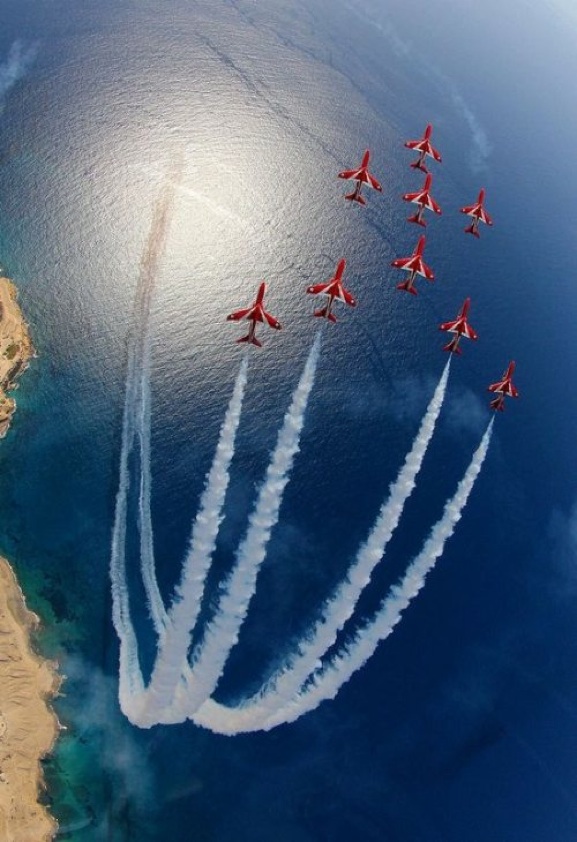
(Actually a curved smoke trail that's only partially vertical, but too cool an image to pass up).

(Actually a curved smoke trail that's only partially vertical, but too cool an image to pass up).
reply to post by Uncinus
That picture has nothing remotely similar to the other pics in the article. Come on. It might as well be taken from a satellite . Let's keep it oranges to oranges and apples to apples.
That picture has nothing remotely similar to the other pics in the article. Come on. It might as well be taken from a satellite . Let's keep it oranges to oranges and apples to apples.
reply to post by CherubBaby
What part of the picture are you seeing as being a vertical trail, and how are you determining perspective?
What part of the picture are you seeing as being a vertical trail, and how are you determining perspective?
Originally posted by CherubBaby
reply to post by Uncinus
That picture has nothing remotely similar to the other pics in the article. Come on. It might as well be taken from a satellite . Let's keep it oranges to oranges and apples to apples.
That is just it.
You posted a photo of an apple but you are calling it an orange so everyone is posting photos of real oranges to show you the difference.
Originally posted by CherubBaby
reply to post by Uncinus
That picture has nothing remotely similar to the other pics in the article. Come on. It might as well be taken from a satellite . Let's keep it oranges to oranges and apples to apples.
My bad, you are quite correct. How about this example:
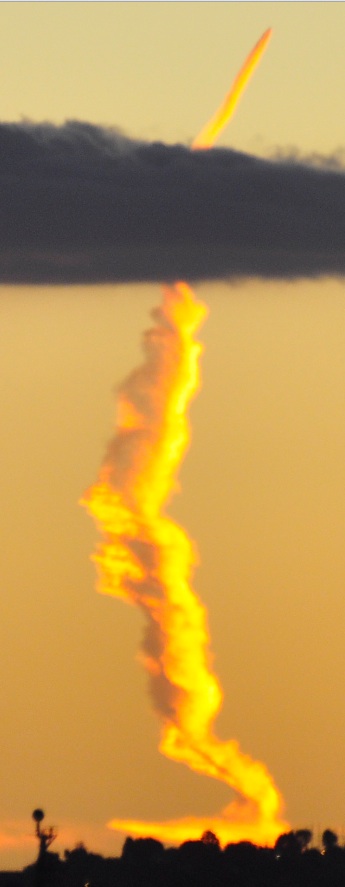
It's a perfectly horizontal contrail, verified by satellite images and correlating images of the plane with radar tracks, and yet because of the extreme angle, and the curvature of the earth, it looks like some kind of missile going straight up.
reply to post by waynos
The same way I determine this one.
Do you see anything in the picture above that looks uniform in the "Thin trail" versus the 2 "Thicker Ones".? Do they appear to be all at the same altitude to you? They don't to me.
The same way I determine this one.
Do you see anything in the picture above that looks uniform in the "Thin trail" versus the 2 "Thicker Ones".? Do they appear to be all at the same altitude to you? They don't to me.
reply to post by CherubBaby
No, not taken from a satellite but from a RAF chase plane.
Could it be, and have you even considered the possibility that you're wrong about those vertical contrails in your OP?
Clearly your observational skills are lacking...
No, not taken from a satellite but from a RAF chase plane.
Could it be, and have you even considered the possibility that you're wrong about those vertical contrails in your OP?
Clearly your observational skills are lacking...
edit on 11/12/12 by Chadwickus because: (no reason given)
Originally posted by CherubBaby
reply to post by waynos
The same way I determine this one.
Do you see anything in the picture above that looks uniform in the "Thin trail" versus the 2 "Thicker Ones".? Do they appear to be all at the same altitude to you? They don't to me.
Do all these cars look like they are at the same altitude?
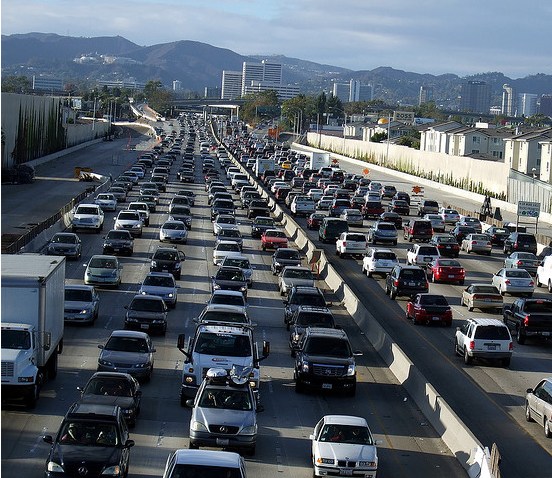
Sure, you can tell they are, because you can see the road, you can see the shape of the cars, you know they are all about the same size. But if you don't have those visual cues, it's a little harder. Imagine a horizontal grid in the sky, what would that look like?
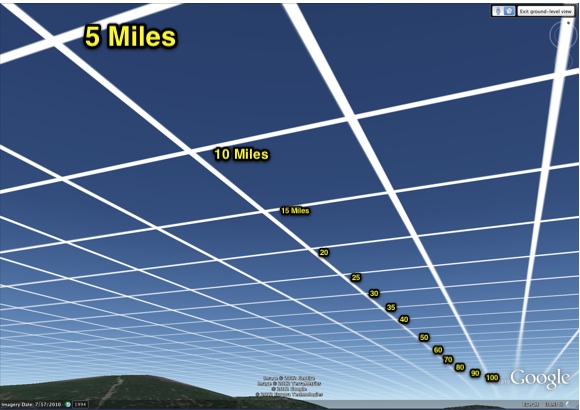
Now imagine you can only see a few fragments of this grid, and they are random sizes because some are older than others.
reply to post by CherubBaby
I am sure that it has already been explained that they are not "vertical" but do to our position on the earth, its curvature and the direction of the plane, it gives the appearance of a vertical movement. Perspective here plays with our sense in what appears to be vertical movement. Because the object is further away and a frame of reference isn't in play, the appearance becomes such.
I am sure that it has already been explained that they are not "vertical" but do to our position on the earth, its curvature and the direction of the plane, it gives the appearance of a vertical movement. Perspective here plays with our sense in what appears to be vertical movement. Because the object is further away and a frame of reference isn't in play, the appearance becomes such.
reply to post by Uncinus
The picture isn't of cars. Let me ask you. What is right or wrong with the picture below? Do the light poles look horizontal? do the 2 clouds resemble the aircraft's trail and angle to the far left of the picture or is that jet flying straight in your opinion?
The picture isn't of cars. Let me ask you. What is right or wrong with the picture below? Do the light poles look horizontal? do the 2 clouds resemble the aircraft's trail and angle to the far left of the picture or is that jet flying straight in your opinion?
reply to post by CherubBaby
looks like all the aircraft were flying straight - some towards teh observer, some "across" the observer, and one of them "diagonally".
there is nothing in that photo that sugests any aircraft was performing a vertical manouvre.
there MAY have been a vertical manouvre involved somewhere with the 2 short contrails........but honestly...given that contrails are an everyday occurrence and issues of required aircraft performance and perspective, they look like normal - ie horizontal (more or less) - contrails made by airliners or similar.
and if you are only going on apparent direction - those poles have a nasty lean - i'd be mentioning them to city maintenance and wondering why the earthquake hadn't been mentioned!!
looks like all the aircraft were flying straight - some towards teh observer, some "across" the observer, and one of them "diagonally".
there is nothing in that photo that sugests any aircraft was performing a vertical manouvre.
there MAY have been a vertical manouvre involved somewhere with the 2 short contrails........but honestly...given that contrails are an everyday occurrence and issues of required aircraft performance and perspective, they look like normal - ie horizontal (more or less) - contrails made by airliners or similar.
and if you are only going on apparent direction - those poles have a nasty lean - i'd be mentioning them to city maintenance and wondering why the earthquake hadn't been mentioned!!
edit on 11-12-2012 by Aloysius the Gaul because: (no reason given)
reply to post by CherubBaby
But there seems to be no more reason to suppose the trails in your image are vertical than there does to suppose the plane in this pic here is about to fly through a vertical trail rising in front of it.

But there seems to be no more reason to suppose the trails in your image are vertical than there does to suppose the plane in this pic here is about to fly through a vertical trail rising in front of it.

edit on 11-12-2012 by waynos because: (no reason given)
Originally posted by CherubBaby
reply to post by Uncinus
The picture isn't of cars. Let me ask you. What is right or wrong with the picture below? Do the light poles look horizontal? do the 2 clouds resemble the aircraft's trail and angle to the far left of the picture or is that jet flying straight in your opinion?
I see nothing "wrong" with it, other than being slightly tilted.
Consider that contrails essentially are like wide road laid out on a flat surface, six miles above you. Like lines drawn on a very high ceiling. Now let's flip that around, and instead of looking UP at the flat layer of contrails, we look DOWN at the flat layer of roads, in this case Las Vegas:
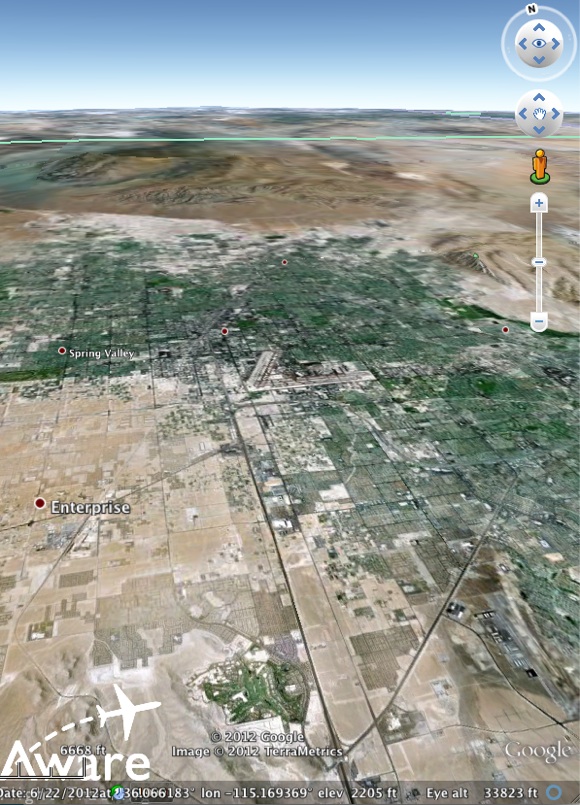
Note the freeway running up through the middle of the picture. Is it vertical? No, it just appears to be because of the angle. It's just as horizontal as the roads running at right angles to it.
Now you know all the roads in the image above are horizontal because you have visual context. You don't have that visual context when looking up at a few trails in the sky. Hence you get this very strong illusion where horizontal trails look vertical.
The illusion even starts to take shape on the ground if we zoom in on a region nearer the horizon, once could almost start to imagine this as a vertical plane, instead of a horizontal one.
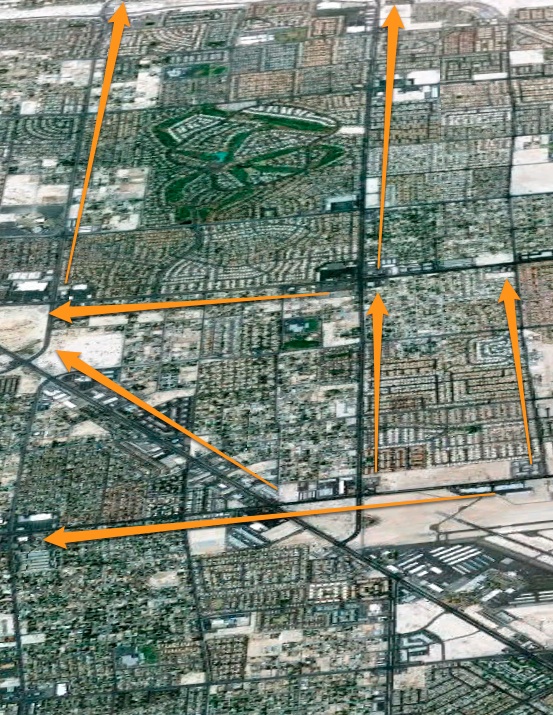
edit on 11-12-2012 by Uncinus because: (no reason given)
reply to post by waynos
Nice try but your picture is irrelevant and also is incomplete as there are no horizons etc etc you we can compare ladies make ups to banana squash but is childish. Your smart enough to know what picture are close or do I need to explain to you with pictures the curvature of the earth and distances, perspectives, etc. I am not here to find out if they are vertical. I am curious why they ARE VERTICAL and FOR WHAT REASON they are VERTICAL. WHAT ARE THE 2 PROTRUSIONS AT THE TOP LEFT OF THE TRAIL ON THE RIGHT SIDE OF THE PICTURE??
Nice try but your picture is irrelevant and also is incomplete as there are no horizons etc etc you we can compare ladies make ups to banana squash but is childish. Your smart enough to know what picture are close or do I need to explain to you with pictures the curvature of the earth and distances, perspectives, etc. I am not here to find out if they are vertical. I am curious why they ARE VERTICAL and FOR WHAT REASON they are VERTICAL. WHAT ARE THE 2 PROTRUSIONS AT THE TOP LEFT OF THE TRAIL ON THE RIGHT SIDE OF THE PICTURE??
new topics
-
Dick Van Dyke saved from Wildfire by neighbours on his 99th birthday
People: 55 minutes ago
top topics
-
Marvin Gabrion's sentence commuted by Biden
US Political Madness: 16 hours ago, 14 flags -
London Christmas Market BANS Word ‘Christmas’
Social Issues and Civil Unrest: 16 hours ago, 12 flags -
1 Billion dollars
General Entertainment: 14 hours ago, 6 flags -
Dick Van Dyke saved from Wildfire by neighbours on his 99th birthday
People: 55 minutes ago, 1 flags
active topics
-
London Christmas Market BANS Word ‘Christmas’
Social Issues and Civil Unrest • 32 • : andy06shake -
Trump says ownership of Greenland 'is an absolute necessity'
Other Current Events • 39 • : Dalamax -
Dick Van Dyke saved from Wildfire by neighbours on his 99th birthday
People • 0 • : gortex -
RIP Merrily Harpur British Big Cat Realist
Cryptozoology • 4 • : TimBurr -
Statements of Intent from Incoming Trump Administration Members - 2025 to 2029.
2024 Elections • 51 • : WeMustCare -
JILL BIDEN Wants JOE to Punish Democrats Who Forced Him to Leave Office in Disgrace on 1.20.2025.
2024 Elections • 15 • : Electriccowboy -
Christmas Dinner ??
Food and Cooking • 15 • : Mantiss2021 -
U.S. Govt Agencies That Protect Criminals in Government - National Archives Records Admin-NARA.
Political Conspiracies • 9 • : 777Vader -
NYPD arrests migrant who allegedly set woman on fire on subway train, watched her burn to death
Breaking Alternative News • 51 • : QET0110 -
Merry Christmas !!
General Chit Chat • 17 • : rickymouse
